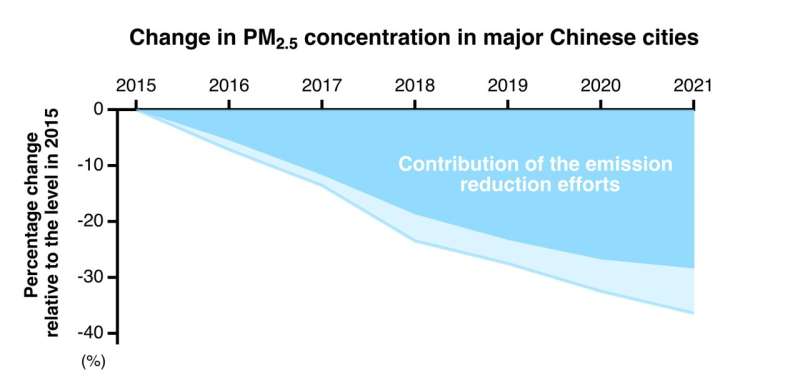This article has been reviewed according to Science X's editorial process and policies. Editors have highlighted the following attributes while ensuring the content's credibility:
fact-checked
peer-reviewed publication
trusted source
proofread
China's ongoing efforts in combating air pollution yield air quality improvements

A new study has been conducted to understand whether the recent changes in China's air quality were driven by meteorological influences or air pollutant emission reduction efforts. It was led by Prof. Yinchang Feng from the College of Environmental Science and Engineering at Nankai University.
Over the past decade, substantial efforts have been made in China to curb air pollutant emissions. The implementation of two well-known and stricter nationwide Clean Air Actions—the "Air Pollution Prevention and Control Action Plan" (commonly known as the "Ten Measures") from 2013 to 2017, and the "Three-Year Action Plan to Win the Battle for a Blue Sky" (commonly known as "Blue Sky Battle") from 2018 to 2020—has played a pivotal role in this improvement.
These actions, issued by the State Council of China, aimed to reduce ambient PM2.5 mass concentration in key regions to target levels, and were supported by a series of policy and control measures. Through determined clean air actions, the nation has achieved a remarkable transformation in the state of its air pollution, resulting in cleaner air for its populace.
China has witnessed a remarkable improvement in ambient air quality, as evidenced by the consistent decrease in the concentrations of major air pollutants and the number of hazy days. In addition to anthropogenic emissions, weather conditions also regulate the variations of air pollution, especially in short-term timescale.
To accurately evaluate the effectiveness of emission reduction efforts, the researchers adjusted the air quality data across 31 major Chinese cities for meteorological influences, using an advanced machine learning based statistical model.
After accounting for meteorological effects, the study confirms that the continuous decline in the annual average concentrations of major air pollutants in the selected 31 major Chinese cities during the 13th Five-Year Plan period (2015-2020) was primarily attributable to the emission reduction programs, particularly the successful control of coal-related combustion emissions.
However, along with the ongoing battle against air pollution, the pace of PM2.5 reduction slowed down. And in some cities, emission rates even rebounded, signaling challenges in achieving further air quality improvement and the increasing difficulty in promoting emission reduction in the future.
The study also highlighted a concerning trend of worsening ozone pollution in some Chinese cities. Co-corresponding author, Prof. Yinchang Feng says, "Despite notable reductions in nitrogen oxides, one of the precursors of ozone, the emissions of other ozone precursors like volatile organic compounds (VOCs) need to be coordinated to prevent further deterioration in ozone air quality."
The paper is published in the journal Science China Earth Sciences.
More information: Qili Dai et al, Quantifying the impacts of emissions and meteorology on the interannual variations of air pollutants in major Chinese cities from 2015 to 2021, Science China Earth Sciences (2023). DOI: 10.1007/s11430-022-1128-1
Journal information: Science China Earth Sciences
Provided by Science China Press




















